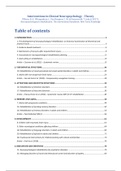Samenvatting
Intervention Strategies (2018/2019) - Summary Wilson et al. (2017) - Neuropsychological rehabilitation
- Instelling
- Universiteit Leiden (UL)
This is an English summary for the course ‘Intervention Strategies - Theory’ at Leiden University. The summary includes all relevant chapters from Wilson’s book (2017; Neuropsychological rehabilitation) and all the extra mandatory literature. Use this extensive summary to prepare for the exam!
[Meer zien]






